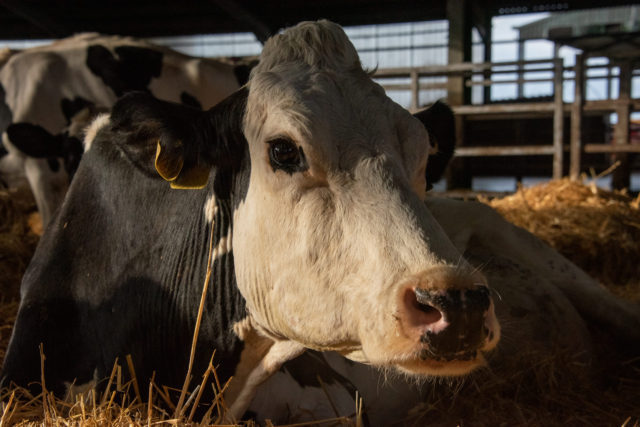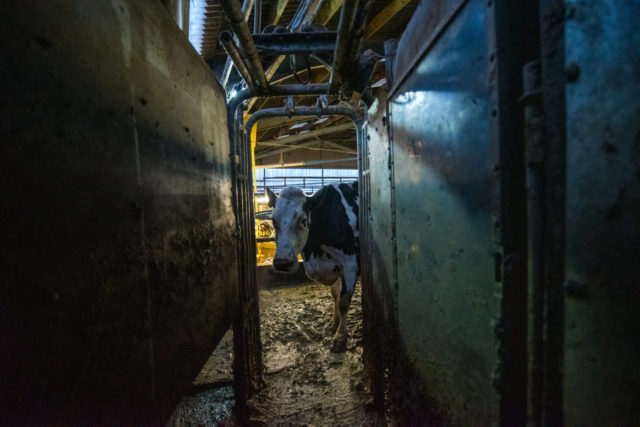
Andrea Arnold’s Cow follows one extraordinary bovine on a cattle farm
COW (Andrea Arnold, 2021)
IFC Center
323 Sixth Ave.
Opens Friday, April 8
www.ifccenter.com
Throughout her nearly two decades as a filmmaker, British writer-director Andrea Arnold has focused on strong women facing such commonplace issues as love, romance, motherhood, and poverty, often portrayed by actors at the beginning of their career. Arnold, a single mother who left school at the age of sixteen to become an actor — and whose own mother had four children by the time she was twenty-two — has created such unique and memorable characters as Zoe (Natalie Press) in the Oscar-winning 2003 short Wasp, Jackie (Kate Dickie) in 2006’s Red Road, Mia (Katie Jarvis) in 2009’s Fish Tank, the young Cathy (Shannon Beer) in 2011’s Wuthering Heights, and Star (Sasha Lane) in 2016’s American Honey. (Females also take the lead in Arnold’s early shorts Milk and Dog.)
But the three-time Cannes Jury Prize winner might have found her truest, most poignant protagonist in her stunning debut documentary, Cow, opening April 8 at IFC. I can’t remember the last time I was so deeply affected by a film, from start to finish; it absolutely exhilarated and pulverized me.
Made over the course of six years, the nonfiction work follows an extraordinary dairy cow named Luma on a cattle farm in the English countryside. Cinematographer Magda Kowalczyk zooms in on Luma’s hooves as she walks through thick mud, her hind quarters (complete with number ID) when she squeezes into a tight area to eat, her udders when she is milked, and her powerful, expressive eyes. Luma often looks right at the camera (or gives great side-eye) as if she knows that her life is on view for all to see as she goes about her daily business, which is decidedly not glamorous.

The unforgettable Cow is Andrea Arnold’s nonfiction debut
We witness Luma giving birth twice; it’s both edifying and heartbreaking watching her clean her newborn calves with her tongue, realizing that she will only see them again in large, anonymous groups, not as mother and daughter. We share her sense of freedom when the cows are given free rein of a vast pasture, although they are eventually gathered up and marched back to their more confined spaces. At one point, it seems that Luma is considering running away; standing at an entrance gate, she looks back and forth between the outside world and the inside ranch before despondently listening to the farmers and returning to her duties.
Are Arnold and Kowalczyk, and therefore the audience, humanizing an animal that is not nearly as sentient as it appears? Luma does seem to be keenly aware of her surroundings and what is happening to her, even more so than the other cows. Her eyes speak volumes, and she calls out often, perhaps complaining about her circumstances, knowing there has to be more to life. Arnold cuts numerous times to point-of-view shots, as if we are seeing this world through Luma’s eyes, interpreting her thoughts.
In their 2017 study “The Psychology of Cows,” Lorin Marino and Kristin Allen wrote, “Domestic cows (Bos taurus) are consumed worldwide as beef and veal, kept as dairy product producers, employed as draft animals in labor, and are used for a long list of other products, including leather and manure. But despite global reliance on cows for thousands of years, most people’s perception of them is as plodding herd animals with little individual personality and very simple social relationships or preferences. Yet, a review of the scientific literature on cow behavior points to more complex cognitive, emotional, and social characteristics. . . . Moreover, an understanding of the capabilities and characteristics of domestic cows will, it is hoped, advance our understanding of who they are as individuals.”
Arnold has not made the film merely to highlight one bovine with extraordinary cognitive abilities; at its heart, Cow is about the connection between humans and nature, as well as between animals (and humans) themselves. There are no experts talking about farming, no screen text sharing facts and information about milk and meat or unsanitary and cruel conditions; although we occasionally see the farmers, we don’t know their names or exactly what they’re doing at certain times. They just keep performing their tasks as if the camera were not on, knowing that Luma is the subject, not them.
Arnold lays everything out there, and we can make our own decisions. She is not trying to convert us to veganism, but she is asking us to take a deeper look into our lives and how we treat other living, sentient beings. The ending will shock, if not surprise, you, and you are likely to never forget it.
Cow deserves to enter the pantheon of memorable films about animals, from Sounder, Old Yeller, and National Velvet to The Black Stallion, Okja, and First Cow, which are all fictional. Here Arnold has given us the real deal, a film that is not always easy to watch but is innately, unforgivingly human.